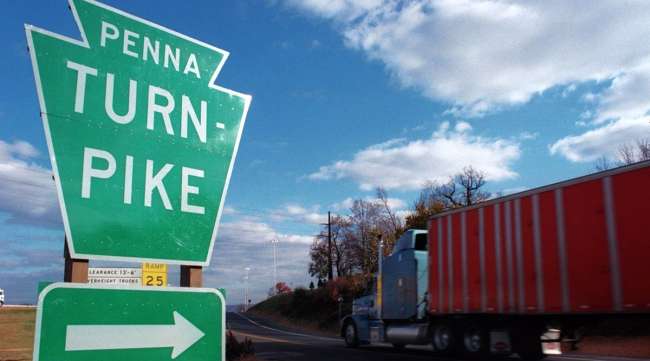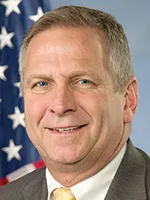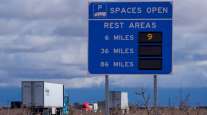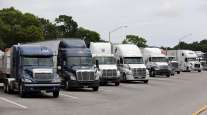Pittsburgh Post-Gazette
Lack of Truck Parking Alarms Pennsylvania Drivers

[Stay on top of transportation news: Get TTNews in your inbox.]
WASHINGTON, Pa. — Truckers nearing the end of their workday before reaching Pittsburgh often seek out the Pennsylvania Turnpike’s New Stanton service plaza to park their rigs for the night.
It’s such a popular location that there aren’t enough spaces for all the truckers who want to rest there. So some just pull over onto the turnpike shoulder because there’s nowhere else to go and they’re not legally allowed to keep driving. Or they line the nearby exit ramps.
That’s what happens when, according to the trucking industry, there’s only one parking space for every 11 trucks on the road across the country, and drivers reach the federally mandated limit on how long they can drive until the next day.
“We see truck parking demand far exceed designated parking capacity, which results in many trucks parking in undesignated areas like highway shoulders and interchange ramps along the Pennsylvania Turnpike,” said George O’Connor, a spokesman for the Owner-Operator Independent Drivers Association. “Truckers don’t want to park on the side of the road, but are forced to if designated parking areas are full and they run out of federally-regulated driving hours.
“This isn’t safe for truck drivers,” he added, “and it’s not safe for the motoring public.”
Under federal regulations, truckers can drive up to 11 hours during a 14-hour window, and an additional two hours if it’s due to bad weather or something unforeseen such as a major crash.
But the parking shortage causes truckers to shorten their workdays by as much as an hour so they have enough driving time remaining to find a place to park for the night — making it harder for them to deliver goods on time. Some exceed the time allowed because they can’t find a place to pull over in time. Some park illegally on freeway shoulders and ramps because they have no other alternatives.
'This isn’t safe': A lack of truck parking on Pennsylvania's highways alarms drivers https://t.co/GiM5q6cRP2 — Pittsburgh Post-Gazette (@PittsburghPG) May 30, 2023
“Whenever I drive at night, I see trucks parked all over the place,” said Zach Callahan, executive director of the Truck Safety Coalition.
No wonder truck drivers listed the lack of parking as their top issue in the American Transportation Research Institute’s 2022 annual industry survey. More than three-quarters of truck drivers said they’ve had problems in the past year trying to find a safe location when they needed to pull off the road for the night.
It’s a concern of safety advocates as well. Driver fatigue was a contributing factor in at least 13 truck crashes investigated by the National Transportation Safety Board since 2011.

Callahan
“If we want drivers not to drive fatigued, we need a place for them to get the rest they need,” Callahan said. “On this issue, there is no question that increased availability of truck parking is going to make the roads safer for all of us.”
The problem isn’t new. The NTSB said in 2000 that the lack of safe available truck parking along major highways was a major concern.
“The federal and state governments have the responsibility to maintain highway safety and the lack of available truck parking or the truck drivers not knowing where parking would be available can negatively impact safety,” the board said then.
So far, Congress hasn’t responded to calls to fund more truck parking.
A $1 billion allocation approved by the House in 2021 never made it into the final version of President Joe Biden’s $1 trillion infrastructure law. And the U.S. Transportation Department’s new safety strategy to eliminate deaths on the nation’s highways was silent on the need for more truck parking.
“It may boil down to not enough members of Congress recognizing the urgency of the availability of safe and available parking spots,” said Harry Adler, principal of the Institute for Safer Trucking.
Now lawmakers are trying again.
In May the House Transportation Committee passed a bill to provide $755 million over three years in grants for new truck parking lots. The money would go to build new facilities or expand existing weigh stations and rest areas. Private companies could also apply for grants but couldn’t charge for parking.

Bost
“These 20 years-plus we have known about the problem, and it gets continuously worse,” said the legislation’s chief sponsor, Rep. Mike Bost (R-Ill.), whose family owns a trucking company.
The committee approved similar legislation in the last Congress, but the bill didn’t reach the House floor until just three weeks were left in the session and it never came up for a vote.
This time, however, the House committee acted early enough to give both the full House and Senate enough time to consider the legislation, Bost said.
“I think it’s going to pass and it should,” he said.
Trucks parked illegally on ramps and shoulders contribute to an increase in traffic fatalities, safety advocates said. The driver of a passing car, for example, may not see a truck trailer jutting out into the highway until it’s too late to avoid being wedged underneath, Adler said. Or a drowsy driver might drift onto the shoulder and crash into a parked truck, Bost said.
“They’re taking a long trip, they’re getting tired, and all of sudden they run off the edge of the road,” Bost said. “And what are they going to do? They’re going to hit a truck. And the truck wins every time.”
The number of people killed in crashes involving trucks weighing more than 10,000 pounds rose 10% during the first six months of 2022 over the previous year, according to National Highway Traffic Safety Administration estimates. That followed a 13% increase in fatalities in large truck crashes from 2020 to 2021.
Pennsylvania was one of the five states that truckers named as the hardest to find a place to put their rigs after their driving is done for the day, according to a U.S. Department of Transportation report. The others were New York, New Jersey, Illinois and Georgia.
The report was required under Jason’s Law. That law was named for Jason Riverberg, who parked in an abandoned gas station when he couldn’t find a place to stop for the night and was murdered for the $7 on his dashboard.
Today's front page: May 30, 2023
Use this link to read today’s edition or subscribe to get access: https://t.co/gCFdVR2Zjs pic.twitter.com/Xc5pqcAYft — Pittsburgh Post-Gazette (@PittsburghPG) May 30, 2023
The lack of parking means that trucks line the turnpike shoulders and ramps in Somerset and Westmoreland counties, according to the state Department of Transportation’s 2045 Freight Movement Plan released earlier this month.
Drivers unable to park at the overcrowded New Stanton service plaza in Hempfield Township who then leave the turnpike to continue west on Interstate 70 looking for a place to spend the night don’t fare much better, according to the state report. The Somerset service area for traffic heading east from Pittsburgh also is operating above capacity.
The reason? Pennsylvania has about 11,600 parking spaces for trucks in its rest areas, welcome centers and turnpike service plazas, state Transportation Department spokesman Zachary Appleby said. Yet during peak hours, some 12,100 trucks park there and an additional 980 wind up on highway shoulders and ramps, he said.
“The truck parking shortage is a critical issue being faced by many states, Pennsylvania included,” Appleby said.
He said a parking study by the state’s Transportation Advisory Committee that’s due by the end of the year will offer ways to build new parking facilities and identify areas where the problem is most severe.
Meanwhile, truck drivers continue to struggle with finding places to rest for the night.
“It gets continuously worse,” Bost said. “They park on the on-ramps, on the off-ramps, on the shoulders, on places that are not safe for them. But it’s also not safe for the person who’s driving a car or a pickup truck.”
Want more news? Listen to today's daily briefing below or go here for more info:
Distributed by Tribune Content Agency, LLC




